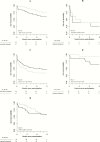Clinical Outcomes of Patients With Drug-Resistant Tuberculous Meningitis Treated With an Intensified Antituberculosis Regimen
- PMID: 28472255
- PMCID: PMC5850451
- DOI: 10.1093/cid/cix230
Clinical Outcomes of Patients With Drug-Resistant Tuberculous Meningitis Treated With an Intensified Antituberculosis Regimen
Abstract
Background: Drug-resistant tuberculous meningitis (TBM) is difficult to diagnose and treat. Mortality is high and optimal treatment is unknown. We compared clinical outcomes of drug-resistant and -susceptible TBM treated with either standard or intensified antituberculosis treatment.
Methods: We analyzed the influence of Mycobacterium tuberculosis drug resistance on the outcomes of patients with TBM enrolled into a randomized controlled trial comparing a standard, 9-month antituberculosis regimen (containing rifampicin 10 mg/kg/day) with an intensified regimen with higher-dose rifampicin (15 mg/kg/day) and levofloxacin (20 mg/kg/day) for the first 8 weeks. The primary endpoint of the trial was 9-month survival. In this subgroup analysis, resistance categories were predefined as multidrug resistant (MDR), isoniazid resistant, rifampicin susceptible (INH-R), and susceptible to rifampicin and isoniazid (INH-S + RIF-S). Outcome by resistance categories and response to intensified treatment were compared and estimated by Cox regression.
Results: Of 817 randomized patients, 322 had a known drug resistance profile. INH-R was found in 86 (26.7%) patients, MDR in 15 (4.7%) patients, rifampicin monoresistance in 1 patient (0.3%), and INH-S + RIF-S in 220 (68.3%) patients. Multivariable regression showed that MDR (hazard ratio [HR], 5.91 [95% confidence interval {CI}, 3.00-11.6]), P < .001), was an independent predictor of death. INH-R had a significant association with the combined outcome of new neurological events or death (HR, 1.58 [95% CI, 1.11-2.23]). Adjusted Cox regression, corrected for treatment adjustments, showed that intensified treatment was significantly associated with improved survival (HR, 0.34 [95% CI, .15-.76], P = .01) in INH-R TBM.
Conclusions: Early intensified treatment improved survival in patients with INH-R TBM. Targeted regimens for drug-resistant TBM should be further explored.
Clinical trials registration: ISRCTN61649292.
Keywords: drug-resistance; isoniazid; levofloxacin; tuberculosis; tuberculous meningitis.
© The Author 2017. Published by Oxford University Press for the Infectious Diseases Society of America.
Figures



References
Publication types
MeSH terms
Substances
LinkOut - more resources
Full Text Sources
Other Literature Sources
Medical

